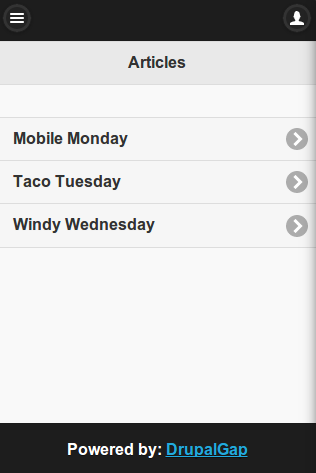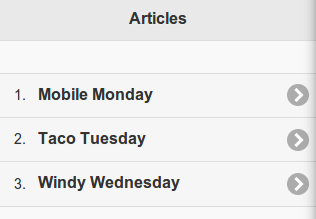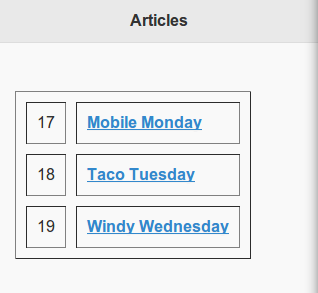Views Render Array
By using a render array, we can take advantage of DrupalGap's built in features for Views.
Formats
We can easily render our view using a few different formats:
- ul
- ol
- table
- unformatted_list (default)
- grid
Unordered List
Here's an example rendering a view as an unordered list (ul):

/**
* Implements hook_menu().
*/
function my_module_menu() {
var items = {};
items['articles'] = {
title: 'Articles',
page_callback: 'my_module_articles_page'
};
return items;
}
/**
* The page callback to display the view.
*/
function my_module_articles_page() {
try {
var content = {};
content['my_articles_list'] = {
theme: 'view',
format: 'ul',
path: 'my-articles', /* the path to the view in Drupal */
row_callback: 'my_module_articles_list_row',
empty_callback: 'my_module_articles_list_empty',
attributes: {
id: 'my_articles_list_view'
}
};
return content;
}
catch (error) { console.log('my_module_articles_page - ' + error); }
}
/**
* The row callback to render a single row.
*/
function my_module_articles_list_row(view, row, variables) {
try {
return l(t(row.title), 'node/' + row.nid);
}
catch (error) { console.log('my_module_articles_list_row - ' + error); }
}
/**
*
*/
function my_module_articles_list_empty(view, variables) {
// This...
return t('Sorry, no articles were found.');
// Or...
var content = {};
content['msg'] = { markup: t('Sorry, no articles were found.') }
// content['some-other-widget'] = { /* ... */ }
return content;
}
Now if we were to navigate to the articles page in our app, we would see our view rendered as an unordered list, with a pager (if there are enough articles for multiple pages).
Ordered List
To render an ordered list, change the format to ol, for example:
format: 'ol',

Table
To render a table, change the format to table, and add some format_attributes (optional), for example:
format: 'table',
format_attributes: {
border: 1,
'cellpadding': 10,
'cellspacing': 10,
},

Note, when using the table format, in your row_callback function, be sure to wrap each column of your row in table data elements, for example:
var html =
'<td>' + row.nid + '</td>' +
'<td>' + l(row.title, 'node/' + row.nid) + '</td>';
return html;
Grid
To render a jQueryMobile Grid, change the format to grid, and add a columns count (optional), for example:
format: 'grid',
columns: 3
The columns count will default to 2 which is also the minimum, the maximum is 5.
No Results
If there were no results available, then the my_module_articles_page_empty function would be called to render the empty text. You can return a plain html string here, or build a Widget(s) and return it as content.
Row Position
When using a row_callback function, the position of the row is located within the row object. For example, we could do extra stuff for the first and last row if we wanted to:
/**
* The row callback to render a single row.
*/
function my_module_articles_list_row(view, row, variables) {
try {
var html = l(row.title, 'node/' + row.nid);
// Use plain text for the first and last rows.
if (row._position == 0 || row._position == view.count - 1) {
html = row.title;
}
return html;
}
catch (error) { console.log('my_module_articles_list_row - ' + error); }
}
Please note, prior to DrupalGap 7.x-1.0-rc3 the position was available here:
row.count
